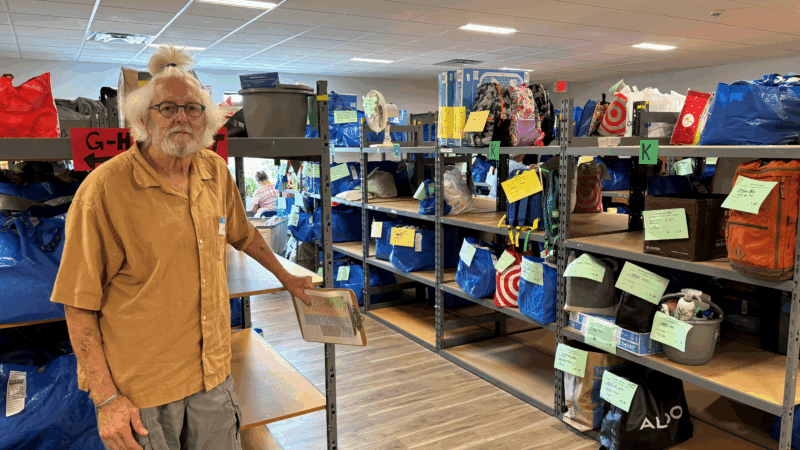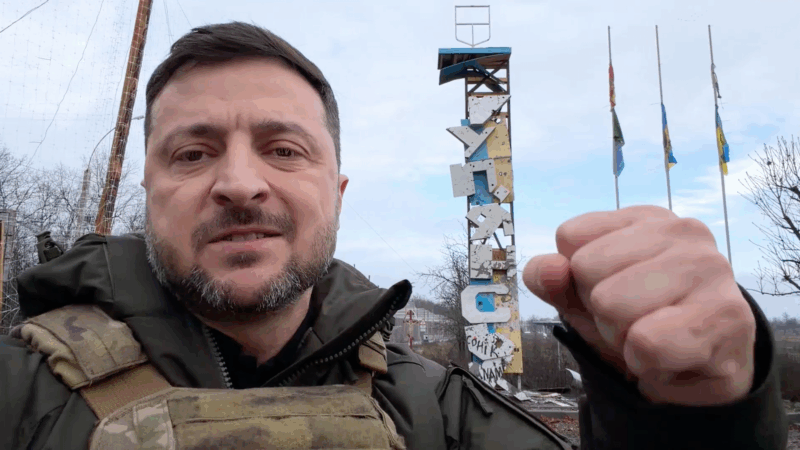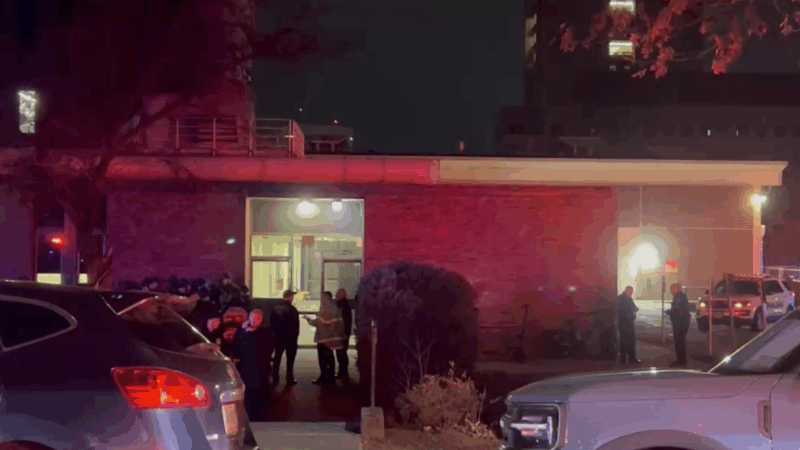Volunteering at ‘Maine Needs’ brings connection to community
PORTLAND, Maine — Seventy-four-year-old Lee Cooper’s favorite thing to do is shop — at least, while he’s volunteering at Portland-based Maine Needs. After he arrives for his shift, he picks up an order slip from the front desk and grabs a bag off a nearby shelf.
“We’ll go fill this up,” Cooper says as he unfolds the bag. “I usually start with shoes because they go on the bottom and they’re heavy.”
Cooper is picking out shoes and other items for a 62-year-old man who has found housing after two years of homelessness. Maine Needs collects donations of clothes, bedding, toiletries, even cleaning supplies and fills specific requests that social workers and other community providers make for clients.
“Think of it like a food bank with no food,” he says. “I mean, we do everything else but food.”

Maine Needs started as a Facebook group out of a garage in 2019. Now, it’s a nonprofit in a 16,000-square-foot facility fueled by more than 3,500 volunteers. It serves the entire state, though most requests come from providers in southern Maine.
In one room, seemingly endless racks of clothing lead to a wall stacked floor-to-ceiling with boxes of boots donated by L.L. Bean. Cooper picks out a pair.
“Oh, those look like those’ll qualify for winter boots,” he says as he inspects them. “Just make sure the size is, yeah — 8 1/2. So, that’s what he requested. We’re able to do that.”
As he works his way down the list, the bag fills up with underwear, socks, pants and shirts.
“And then he also wants some cleaning things, so we’ll have to go in the other room for that,” says Cooper after he drops toothpaste and a couple toothbrushes in the bag.
Cooper doesn’t meet the people he’s shopping for, but he still feels a connection. He recalls an especially memorable order for a woman who was moving into a sober house after being incarcerated.

“I know what it’s like in early sobriety,” he says. “I’ve been sober for 33 years. And I did the best packing job I could for her. Tried to pick the prettiest, the newest. And then I gave her a minute-for-mom kit, which is a kit we do for moms as a rule, which has fancy soap and sometimes a hairbrush or other things that people wouldn’t normally ask for. And then I gave her a deck of cards and I wrote her a note that just said, ‘Good luck in your sobriety.’ I hope she’s doing well. That’s all I can say, because I’ll never know.”
Throughout his adult life, Cooper has carved out time to volunteer. He has supported several conservation groups as well as Habitat for Humanity. At Maine Needs, he started out donating money. But last November, Cooper says he wanted to do something more tangible. He now volunteers at least twice a week and often brings in donations he has collected.
Items tend to move quickly. A dish drainer and duffel bag he brought in this morning are gone by lunchtime.
Cooper says the broader community is also quick to respond when certain items are in demand.
“What happens a lot is we put a request out on Instagram or Facebook: ‘We’re out of fans. Could people please donate?’ And the next thing we know, UPS is delivering 20 fans from three or four different people who bought them and had them shipped to us,” he says.
Jo Albanese, who oversees volunteers at Maine Needs, says so far this year they’ve filled more than 9,500 orders, some of which are for multiple families. Albanese says they couldn’t do it without volunteers like Cooper. He jumps in to help wherever needed.
“He’s done everything from filling orders to painting walls multiple times, you know, like, very easy going soul and just lovely to be, be around,” she says.
But Cooper says he didn’t always see himself that way.
“I was not always a kind person,” he says. “I mean, I thought I was kind, but I was self-serving.”
While volunteering at Maine Needs, he sees how so many people need so much. And that, he says, keeps him grounded.
To tell us your own story about how being a volunteer has shaped your life or nominate someone you think we should profile, fill out this form.
Transcript:
SCOTT DETROW, HOST:
Carving out time to volunteer is something of a habit for Lee Cooper of Kittery, Maine. Throughout his adult life, the 74-year-old has supported several conservation groups as well as Habitat for Humanity. But when he recently tried a new volunteer gig, he discovered his niche and a deeper connection to his community. Patty Wight of Maine Public Radio has the latest story in our series on volunteerism in America, Here to Help.
PATTY WIGHT, BYLINE: Lee Cooper’s favorite thing to do is shop, at least while he’s volunteering at Portland-based Maine Needs. After he arrives for his shift, he picks up an order slip from the front desk and grabs a bag off a nearby shelf.
(SOUNDBITE OF PAPER BAG RUSTLING)
LEE COOPER: We’ll go fill this up. I usually start with shoes because they go on the bottom, and they’re heavy.
WIGHT: Cooper is hand-picking shoes and other items for a 62-year-old man who’s found housing after two years of homelessness. Maine Needs collects donations of clothes, bedding, toiletries, even cleaning supplies and fills specific requests that social workers and other community providers make for clients.
COOPER: Think of it as a – like, a food bank with no food. I mean, we do everything else but food.
WIGHT: Maine Needs started as a Facebook group out of a garage in 2019. Now it’s a nonprofit in a 16,000 square-foot facility fueled by more than 3,000 volunteers. In one room, seemingly endless racks of clothing lead to a wall stacked floor to ceiling with boxes of boots donated by L.L.Bean. Cooper picks out a pair.
(SOUNDBITE OF PAPER RUSTLING)
COOPER: Oh, those look like they’ll qualify for winter boots.
WIGHT: As he works his way down the list, the bag fills up with underwear, socks, pants and shirts.
COOPER: And then he also wants some cleaning things, so I’ll have to go in the other room for that.
WIGHT: Cooper doesn’t meet the people he’s shopping for, but he still feels a connection. He recalls an especially memorable order for a woman who was moving into a sober house after being incarcerated.
COOPER: I know what it’s like in early sobriety. I’ve been sober for 33 years. I did the best packing job I could for her. I tried to pick the prettiest, the newest, I mean – and then I gave her a minute-for-mom kit, which is a kit we do for moms as a rule, which has fancy soap and sometimes a hairbrush or other things that people wouldn’t normally ask for. And then I gave her a deck of cards. And I wrote her a note that just said, good luck in your sobriety. I hope she’s doing well. That’s all I can say ’cause I’ll never know.
WIGHT: Cooper started out donating money to Maine Needs. But last November, he says he wanted to do something more tangible. He now volunteers at least twice a week and often brings in donations he’s collected. Jo Albanese, who oversees volunteers at Maine Needs, says Cooper jumps in to help wherever needed.
JO ALBANESE: He’s done everything from filling orders to painting walls multiple times (laughter), you know, like, very easygoing soul and just – yeah, lovely to be around.
WIGHT: But Cooper says he didn’t always see himself that way.
COOPER: I was not always a kind person. I mean, I thought I was kind, but I was self-serving.
WIGHT: Volunteering at Maine Needs, he sees how so many people need so much and that, he says, helps bring him back to the ground. For NPR News, I’m Patty Wight in Portland, Maine.
DETROW: And we want to hear from you. To tell us your own story about how being a volunteer has shaped your life or to nominate someone you think we should profile, go to npr.org and search Here to Help.
Tanning bed users are at higher risk of skin cancer, especially in unusual places
Indoor tanning is trending among Gen Z. A new study finds tanning bed users not only have a much higher risk of melanoma, they also have DNA damage linked to cancer across nearly their entire skin.
Voices of experience and hope soar in a song to prevent suicide
"Hold the Hope" was sparked by one woman's experience as a caregiver to someone who survived suicidal struggles. It started as a poem that has become a film, a song and even a dance.
Gunmen kill 9 people at Sydney’s Bondi Beach, injuring 11 others
Two gunmen have shot dead nine people at Sydney's Bondi Beach, with eleven wounded, including two police officers. Police shot dead one gunman, second was arrested in critical condition.
US envoys arrive in Berlin for latest round of Ukraine peace talks with Zelenskyy
U.S. President Donald Trump's special envoy Steve Witkoff and son-in-law Jared Kushner will meet Ukrainian leader Volodymyr Zelenskyy on Sunday, as Trump grows increasingly exasperated by delays.
With federal relief on the horizon, Black farmers worry it won’t come soon enough
At the National Black Growers Council meeting in New Orleans, Black farmers respond to the $12 billion in tariff relief announced by the Trump administration and outline challenges farms are facing.
Multiple people shot near Brown University, police say
Brown University says it's working with law enforcement to search for a suspect after its report of an "active shooting situation" on its Rhode Island campus.








